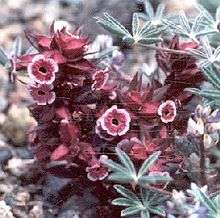Diplacus mohavensis
Diplacus mohavensis is a species of monkeyflower known by the common name Mojave monkeyflower.[1][2][3][4]
| Diplacus mohavensis | |
|---|---|
 | |
| Scientific classification | |
| Kingdom: | Plantae |
| Clade: | Tracheophytes |
| Clade: | Angiosperms |
| Clade: | Eudicots |
| Clade: | Asterids |
| Order: | Lamiales |
| Family: | Phrymaceae |
| Genus: | Diplacus |
| Species: | D. mohavensis |
| Binomial name | |
| Diplacus mohavensis (Lemmon) G.L.Nesom | |
| Synonyms[1] | |
| |
Distribution
It is endemic to San Bernardino County, California, where it is known only from the Mojave Desert. It has been found in several locations in and around Barstow, often in gravelly, sandy habitat such as arroyos.
The historical range of the plant was wider than it is today; many occurrences have been extirpated.[5] The population sizes and abundance vary, as they probably depend on annual rainfall amounts.[6]
Description
Diplacus mohavensis is a small, hairy annual herb growing at ground level or erect to a maximum height near 10 centimeters. The oppositely arranged leaves are narrow oval in shape and under 3 centimeters in length. The herbage is usually reddish green to red-purple in color. The tubular base of the tiny flower is encapsulated in a hairy, ribbed calyx of red sepals with pointed lobes. The flower has a flat face with five rounded, equal lobes. The corolla lobes are dark-veined pink at the bases and white at the edges. It blooms between April and June.[6]
References
- Barker, W. L. (Bill); et al. (2012). "A Taxonomic Conspectus of Phyrmaceae: A Narrowed Circumscription for MIMULUS, New and Resurrected Genera, and New Names and Combinations" (PDF). Phytoneuron. 39: 1–60. ISSN 2153-733X.
- Beardsley, P. M.; Yen, Alan; Olmstead, R. G. (2003). "AFLP Phylogeny of Mimulus Section Erythranthe and the Evolution of Hummingbird Pollination". Evolution. 57 (6): 1397–1410. doi:10.1554/02-086. JSTOR 3448862.
- Beardsley, P. M.; Olmstead, R. G. (2002). "Redefining Phrymaceae: the placement of Mimulus, tribe Mimuleae, and Phryma". American Journal of Botany. 89 (7): 1093–1102. doi:10.3732/ajb.89.7.1093. JSTOR 4122195. PMID 21665709.
- Beardsley, P. M.; Schoenig, Steve E.; Whittall, Justen B.; Olmstead, Richard G. (2004). "Patterns of Evolution in Western North American Mimulus (Phrymaceae)". American Journal of Botany. 91 (3): 474–4890. doi:10.3732/ajb.91.3.474. JSTOR 4123743. PMID 21653403.
- "California Native Plant Society Rare Plant Profile". Archived from the original on 2012-03-26. Retrieved 2011-07-07.
- McKay, P. J. Mojave Monkeyflower Species Profile